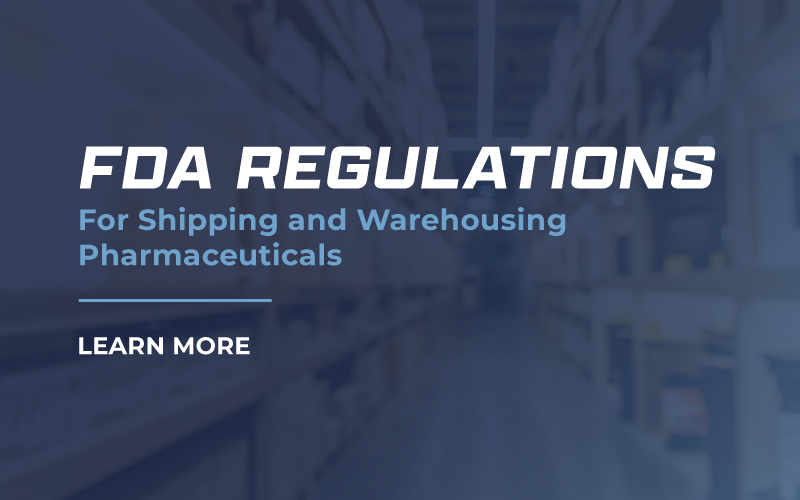The Food and Drug Administration (FDA) sets state licensing laws for all pharmaceutical companies. Title 21 of the Code of Federal Regulations elaborates on these regulations.
These regulations serve to keep the pharmaceuticals and the community safe. Title 21 regulates pharmaceutical shipping, warehousing, distribution, and record keeping.
Who Title 21 Applies To:
- Wholesale drug distributors
- Their officers, agents, representatives, and employers
What Title 21 Applies To:
- The storage and handling of prescription drugs
- Prescription drug distribution records
Sections of Title 21
This blog will outline and expound on each section of Title 21 and how it affects the pharma shipping process and transportation of pharmaceuticals.
- Facilities
- Security
- Storage
- Examination of materials
- Returned, damaged, and outdated prescription drugs
- Recordkeeping
- Written policies and procedures
- Responsible persons
- Compliance with federal, state, and local law
- Salvaging and reprocessing
Facilities, Security, and Storage of Pharma Products (a,b,c)
Warehousing is one of the most significant parts of any form of logistics. It takes detailed organization to do it right, and in the pharmaceutical industry, detail is crucial for success and patient safety. The first three sections of Title 21 detail the FDA’s facility requirements, security specifications, and storage necessities.
Section A: Facilities
Section A applies to all facilities that store, warehouse, handle, hold, offer, market, or display prescription drugs. This section outlines specifications regarding size, environment necessities (lighting, ventilation, temperature, etc.), quarantine spaces for defective drugs, and cleanliness.
Section B: Security
Section B mandates secure measures for entrance into the facility, well-lit outside perimeters, and adequate alarm systems for after-hour entry. In addition, the facility’s security system must prevent theft and diversion physically and electronically.
Section C: Storage
Section C outlines specifications regarding the physical parameters that pharmaceutical storage must uphold. These parameters require thoughtful attention to maintain temperature. “Controlled” room temperature must be available for products that require no storage specifications.
Also, temperature and humidity recording equipment are required to keep detailed records of the storage environments of each drug. Learn more about cold chain logistics. [INSERT LINK FOR BLOG POST]
Section F outlines the requirements for recordkeeping.
Pharmaceutical Shipment Examination of Materials (d,e,f)
It is essential to verify that all pharmaceuticals taken into the warehouse and sent out are in a pristine and safe condition. Therefore, sections D and E ensure that all drugs are evaluated upon arrival and departure, and section F ensures that all drug distributors record procedures effectively.
Section D: Examination of Materials
Section D ensures that all pharmaceuticals shipped are uncontaminated and acceptable for distribution. In addition, all drugs must be inspected for outgoing shipments to ensure they weren’t damaged or stored in inappropriate conditions. These procedures will also be recorded, following section F’s guidelines regarding incoming and outgoing pharmaceutical shipments.
Section E: Returned, Damaged, and Outdated Prescription Drugs
Section E mandates that any corrupted drug must be quarantined in a specified area to either be returned to the supplier or destroyed. According to section F’s guidelines, quarantined, destroyed, and returned pharmaceutical products must be recorded.
Drugs that must be quarantined include:
- Outdated
- Damaged
- Deteriorated
- Misbranded
- Adulterated
- Broken Seal
Section F: Recordkeeping
As noted many times above, Section F relates to other sections outlining specific procedures, requiring inventories and records of every transaction’s arrival and departure. These records must be accessible for inspection and photocopying for Federal, State, and local law enforcement up to 3 years after being created.
Records must include:
- Name and address of seller or transferor
- Address where the drug was shipped from
- Identity and quantity of each drug
- Date of arrival and departure
Federal, State, and Local Inspections
Sections G, H, and I lay out instructions for warehouses to remain organized and prepared for inspections and disasters.
Section G: Written Policies and Procedures
Section G requires you to keep detailed written policies and procedures. These write-ups must include procedures for pharma transport, recalls, and quarantine of drugs and crises, whether natural, organizational, or governmental.
Section H: Responsible Persons
Section H necessitates that a list must be kept of all responsible personnel of wholesale drug distribution, storage, and handling. This list must detail their duties and qualifications.
Section I: Compliance with Federal, State, and Local Laws.
Section I mandates that all wholesale drug distributors must allow federal, state, and local laws enforcement officials to administrate a full inspection, which includes:
- Inspection of premises and delivery vehicles
- Audit of records and written operating procedures
This section also requires wholesale drug distributors to register with the appropriate state authority and the Drug Enforcement Administration (DEA).
Stay Informed!
Every journey begins with understanding. If you found this blog informative, explore some of our other content to learn more about medical logistics.


